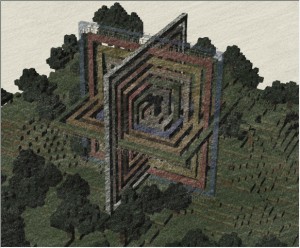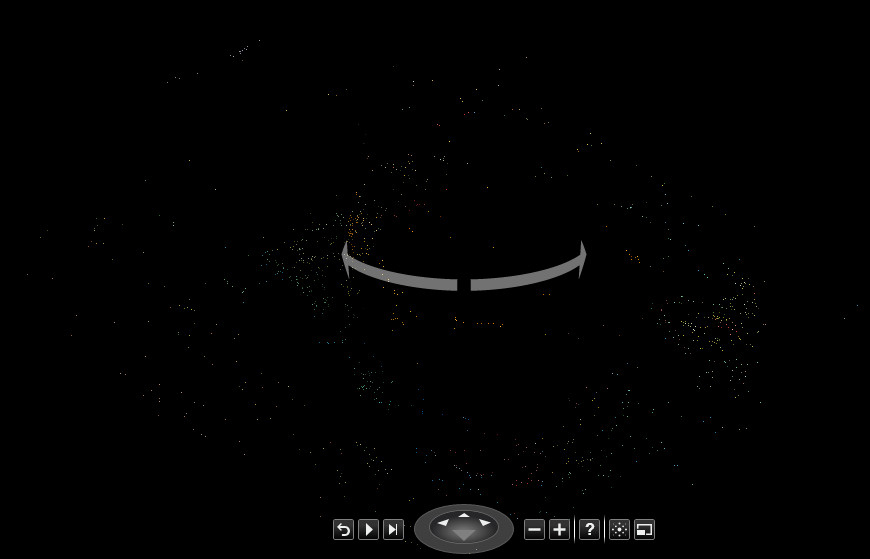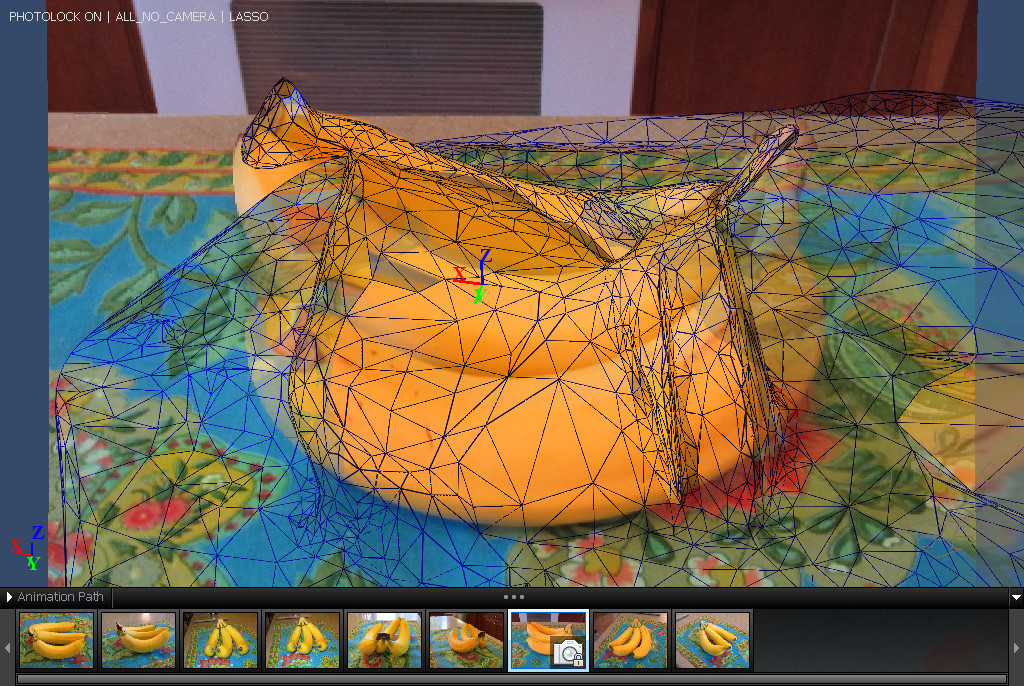The High Performance Graphics 2012 Call for Participation is up, go get it. HPG 2012 is in Paris (France, not Texas) June 25-27, co-located with EGSR, another excellent symposium.
Category Archives: Resources
Bloxing Day
My crazy-person project for the month is done. It’s a little program called Mineways, which is a bridge between Minecraft and Shapeways, the 3D printing service. You can grab a chunk of a Minecraft world for rendering or 3D printing. See the Mineways Flickr group for some results.
Seven Things for 10/13/2011
- Fairly new book: Practical Rendering and Computation with Direct3D 11, by Jason Zink, Matt Pettineo, and Jack Hoxley, A.K.Peters/CRC Press, July 2011 (more info). It’s meant for people who already know DirectX 10 and want to learn just the new stuff. I found the first half pretty abstract; the second half was more useful, as it gives in-depth explanation of practical examples that show how the new functionality can be used.
- Two nice little Moore’s Law-related articles appeared recently in The Economist. This one is about how the law looks to have legs for a number of more years, and presents a graph showing how various breakthroughs have kept the law going over the past decades. Moore himself thought the law might hold for ten years. This one talks about how computational energy efficiency is doubling every 18 months, which is great news for mobile devices.
- I used to use MWSnap for screen captures, but it doesn’t work well with two monitors and it hangs at times. I finally found a replacement that does all the things I want, with a mostly-good UI: FastStone Capture. The downside is that it actually costs money ($19.95), but I’m happy to have purchased it.
- Ray tracing vs. rasterization, part XIV: Gavan Woolery thinks RT is the future, DEADC0DE argues both will always have a place, and gives a deeper analysis of the strengths and weaknesses of each (though the PITA that transparency causes rasterization is not called out) – I mostly agree with his stance. Both posts have lots of followup comments.
- This shows exactly how far behind we are in blogging about SIGGRAPH: find the Beyond Programmable Shading course notes here – that’s just a mere two months overdue.
- Tantalizing SIGGRAPH Talk demo: KinectFusion from Microsoft Research and many others. Watch around 3:11 on for the great reconstruction, and the last minute for fun stuff. Newer demo here.
- OnLive – you should check it out, it’ll take ten minutes. Sign up for a free account and visit the Arena, if nothing else: it’s like being in a sci-fi movie, with a bunch of games being played by others before your eyes that you can scroll through and click on to watch the player. I admit to being skeptical of the whole cloud-gaming idea originally, but in trying it out, it’s surprisingly fast and the video quality is not bad. Not good enough to satisfy hardcore FPS players – I’ve seen my teenage boys pick out targets that cover like two pixels, which would be invisible with OnLive – but otherwise quite usable. The “no download, no GPU upgrade, just play immediately” aspect is brilliant and lends itself extremely well to game trials.
Seven things for 10/10/11
- If you can get WebGL running properly on your browser, check out Shader Toy. Coolest thing is that you can edit any shader and immediately try it out.
- Another odd little WebGL application is a random spaceship maker, with a direct tie-in to Shapeways to buy a 3D version of any model you make.
- Speaking of Shapeways, I liked their “one coffee cup a day project“. The low-resolution cup is particularly good for computer graphics people, though I’m told that in real life it’s a fair bit more rounded off, due to the way the ceramic sets. Ironic. Also, note that these cups are actually quite small in real life (smaller than even espresso cups), which is too bad. Still, clever.
- Source code for iOS versions of Castle Wolfenstein and the original DOOM is now available.
- Patrick Cozzi has a nice rundown of his days at SIGGRAPH this August, with a particular emphasis on OpenGL and mobile. The links for each day are at the bottom of the entry.
- Nice fractal video generated in near-real time (300 ms/frame) running a GLSL shader using this code. Reddit thread here, about an earlier video now pulled back online.
- This site gives a darn long list of educational institutions offering videogame design degrees. It’s at least a place to start, if you’re looking for such things. That said, I’ve heard counterarguments from game company professionals to such specialized degrees, “just learn to program well and we’ll teach you the videogames business”.
Bonus thing: Draw a curve of your data for a number of years and see what it most closely correlates. Peculiar.
AMD CubeMapGen is now Open Source
UPDATE 9/1/2011: ignotion has put the source up on Google Code.
For a long time, I’ve found ATI’s (now AMD’s) CubeMapGen library to be an indispensable tool for creating prefiltered environment maps (important for physically based shading). Many older GPUs (all the ones in current consoles) do not filter across cube faces. CubeMapGen solves this problem and others – details can be found in a GDC presentation and a SIGGRAPH sketch, both from 2005.
Support for CubeMapGen has been spotty for the last few years, and a while ago AMD officially declared its end of life. Since then I’ve been wondering when AMD would open-source this important tool – there is a good precedent in NVIDIA texture tools, which has been open source for several years now.
Speaking of NVIDIA texture tools, a comment on its Google Code website just let me know that AMD has released source to CubeMapGen. A link to the source for version 1.4 can be found on the bottom of the CubeMapGen page. Note that this does not include the DXT compression part of the edge fixup (which was a pretty nifty feature – hopefully someone will reimplement it now that the library is open source).
Looking at the license doc in the zip file, the license appears to be a modified BSD license. This is excellent news – tools like this are far more useful when source is available. Perhaps someone should host the code on Google Code or github, to make it easier to add future improvements – or maybe it could be folded into the nvidia_texture_tools code base (if the license allows).
Advances in RTR Course Notes up
I’m finally back from a nice post-SIGGRAPH vacation in the Vancouver area. Both our computers broke early on in the trip, so it was a true vacation.
I hope to post on a bunch of stuff soon, but wanted to first mention something now available: the slides and videos presented in the popular SIGGRAPH course “Advances in Real-Time Rendering in 3D Graphics”. Find them here, and the page for previous years (well, currently just 2010) here. Hats off to Natalya Tatarchuk and all the speakers for quickly making this year’s presentations available.
A.K. Peters books at SIGGRAPH and beyond
OK, so I like the publisher A.K. Peters, for obvious reasons. They’re also kind/smart enough to send me review copies of upcoming graphics-related books. I’ve received two recently, with one of particular interest:
… and free to veterans and unemployed professionals
Mauricio Vives pointed out that the Autodesk program I mentioned yesterday, where students and educators can get Autodesk products and training for free, also applies to veterans and “displaced professionals.” See this page for the logic. The fine print on the registration page is:
An Autodesk Assistance Program participant is either a veteran or unemployed individual who has (a) previously worked in the architecture, engineering, design or manufacturing industries, has completed the online registration for the Autodesk Assistance Program, and upon request by Autodesk is able to provide proof of eligibility for that program.
This is a nice thing.
All Autodesk software free to students and educators, and betas for everyone
I think I need to pop my head out of my gopher-hole more often and see what my company’s doing. It turns out Autodesk software – including Maya, 3DS Max, Mudbox, AutoCAD, and everything else – is now free to students and educators. Just register and you’re good to go. Wow, this is a big change from the old system, and is definitely great to see.
There are also a number of betas from Autodesk free to anyone: one is 123D, a modeler that is aimed to help out the Maker crowd and 3d printing. I’ve installed this but haven’t played with it yet.
Another project is Photofly 2.0, where you upload a number of images and it makes a 3D model from the data (i.e., photogrammetry). This is similar to My3dScanner. I tried these two out on a set of photos of a bunch of bananas, some taken with a flash and some without, a hard test case. I definitely didn’t follow the guidelines. My3dScanner threw up its hands, Photosynth’s point cloud was incomprehensible, Photofly gave it a sporting chance, getting a cloud and making a mesh – no magic bullet yet, but fun to try. I’m now even tempted to RTFM, as results were better than I thought.
Photosynth (examine set of photos here):
Photofly’s cubist rendering – it did output an interesting Wavefront OBJ model:
Some Info on the SIGGRAPH 2011 Papers
The SIGGRAPH 2011 papers were recently made available in the ACM Digital Library (see here). Although I recommend using Ke-Sen’s excellent papers links page when possible (it links to the freely accessible author copies and often to additional information provided by the authors), not all authors have chosen to make their papers available in this way. The Digital Library itself is pretty expensive (unless you’re a full-time student – see below), but if all you want is the SIGGRAPH stuff (including other conferences sponsored by SIGGRAPH), then a SIGGRAPH membership can get you access. SIGGRAPH memberships are only $42 ($30 for students, but students can get full Digital Library access with an ACM student membership for $42, which looks like a better deal).
In addition, for the first time ACM has published a document which includes the first page of each paper – kind of a paper version of the SIGGRAPH Papers Fast-Forward. This document is freely accessible here, and should be useful for people who just want to skim the papers program and see which papers to read in full. Be warned that the document is a bit large though (184MB). The video preview of the papers program might also be of interest (note that it only covers a few of the papers).
[Eric chiming in: here’s the link for how to access the Digital Library if you’re a SIGGRAPH member. Note that you can access all issues of ACM TOG as well as all SIGGRAPH-sponsored conference material and journals, not just SIGGRAPH, which is just about everything you’d want for graphics conferences: I3D, HPG, EGSR, NPAR, etc. Also, remember that the cool kids say SIG-GRAPH, not SEE-GRAPH.]




